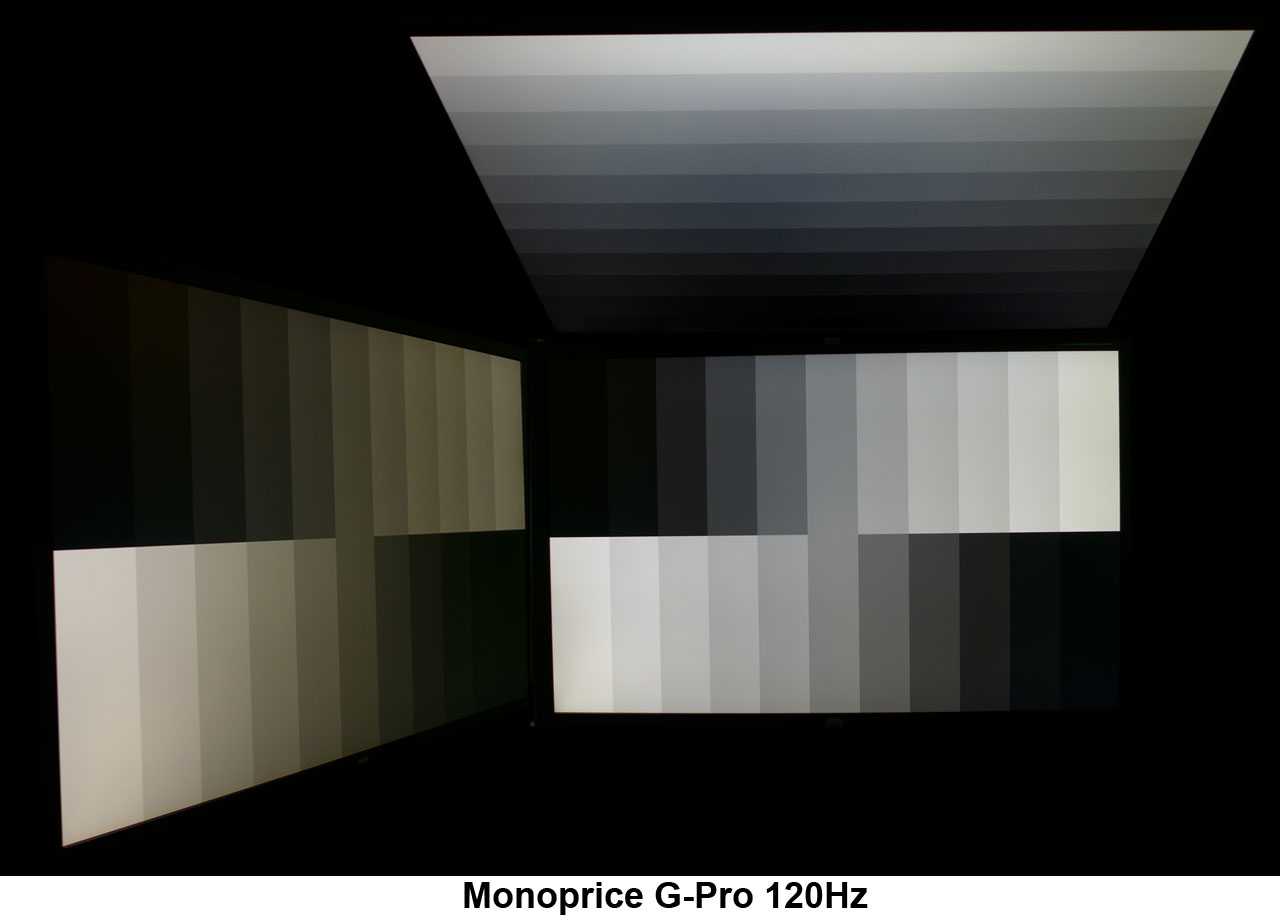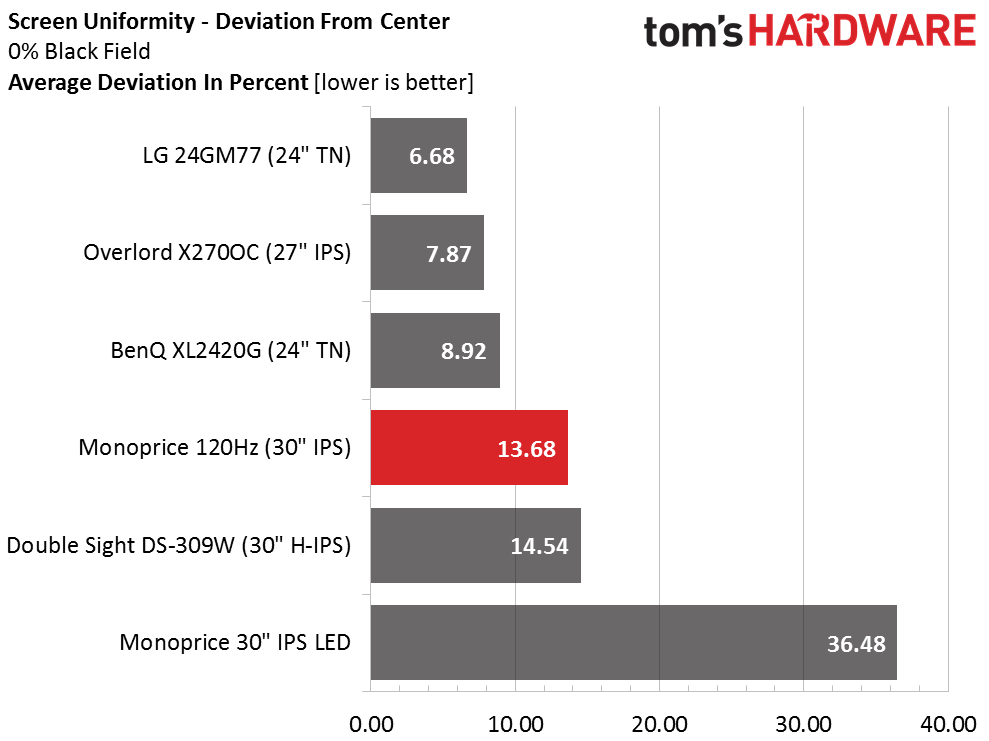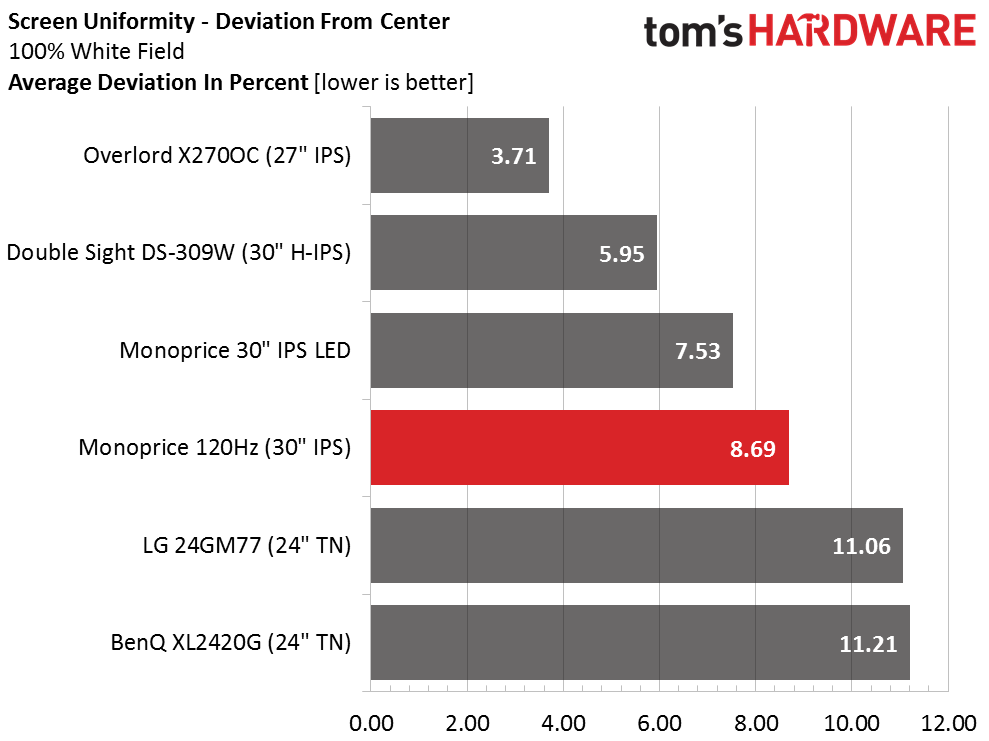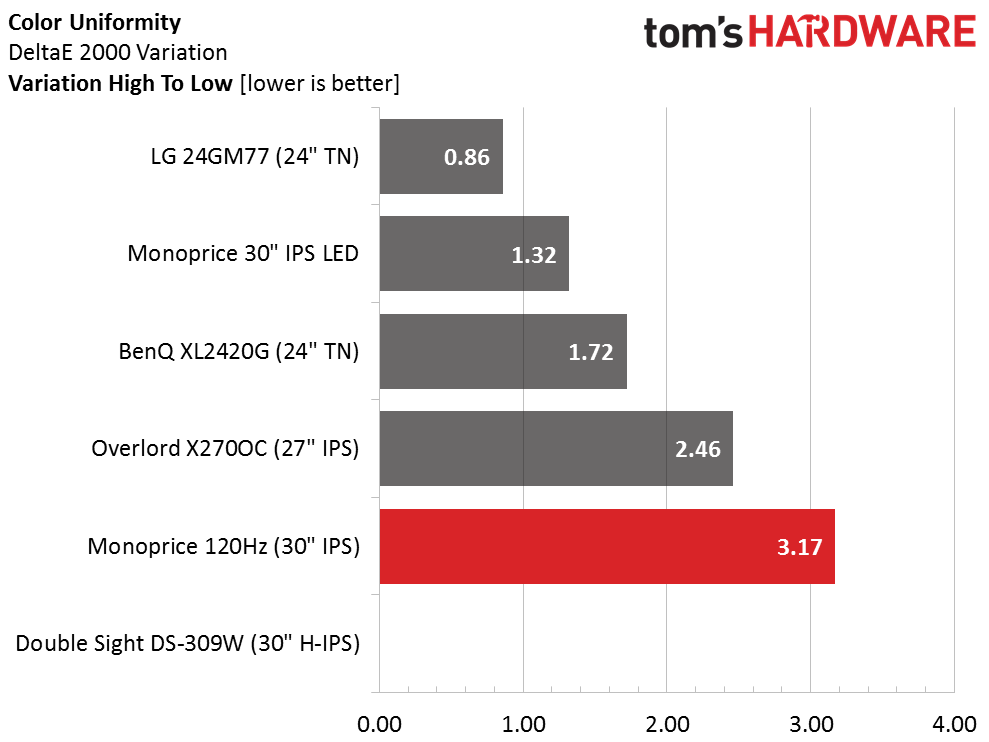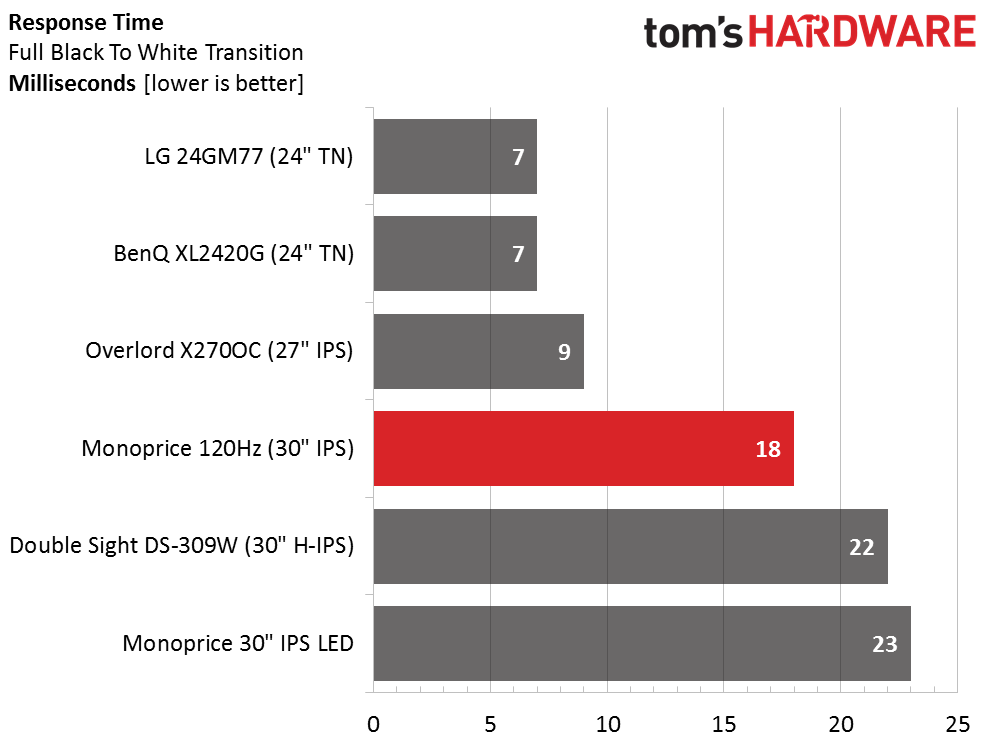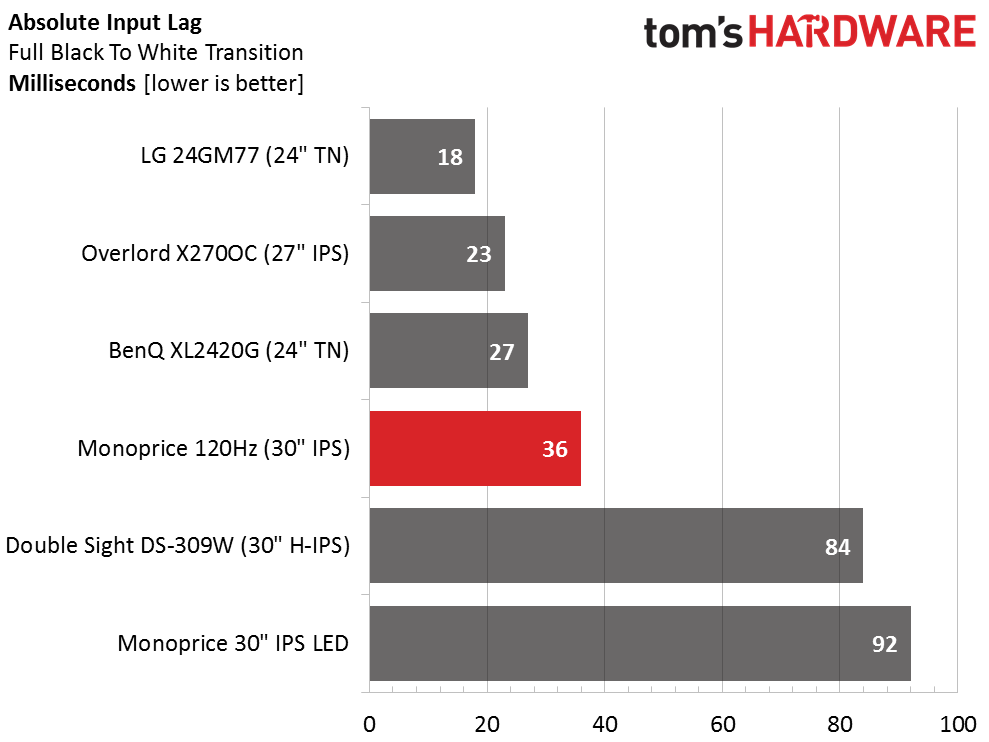Monoprice G-Pro 30-Inch 120Hz IPS Gaming Monitor Review
So far we’ve only had the chance to test one 120Hz IPS monitor, Overlord’s X270OC. Now Monoprice has brought its G-Pro 120Hz 30-inch 16:10 screen to the fast IPS party. Today we see how it performs in our benchmark suite.
Why you can trust Tom's Hardware
Results: Viewing Angles, Uniformity, Response And Lag
To learn how we measure screen uniformity, please click here.
Viewing angle performance is the primary reason gamers are clamoring for more IPS options. The technology is certainly better than TN in this regard, but it isn’t perfect. The G-Pro shows a green shift at 45 degrees with a visible light falloff. Shadow detail holds up extremely well, however. In the top-down photo, there is a reduction in gamma, though you can still clearly see all the brightness steps. When a display is this large, IPS or VA is pretty much mandatory.
Screen Uniformity: Luminance
A 13.68-percent result suggests there is a little light bleed in our specific sample. The only hot spot we can actually see is in the lower-right corner. That zone is .05cd/m2 brighter than the rest of the screen, which is otherwise uniform.
Here’s the white field measurement:
The white field result is comfortably below 10 percent, which is our standard. There are no visible problems anywhere on the screen. You can see that the two TN-based monitors, while decent, aren’t quite up to the uniformity level demonstrated by the IPS displays.
Screen Uniformity: Color
We reviewed the DS-309W quite a while ago and weren’t collecting color uniformity data back then, which is why its result is blank. The G-Pro shows a little color shifting on the right side of the screen. While the rest of the zones look perfectly white, the three on the right show a subtle green tint. We’re nitpicking for sure; you won’t see a problem in real-world content.
Pixel Response And Input Lag
Please click here to read up on our pixel response and input lag testing procedures.
Get Tom's Hardware's best news and in-depth reviews, straight to your inbox.
While the G-Pro 120Hz doesn't quite post the speedy response of a TN panel, or even Overlord’s IPS model, it’s still faster than the majority of 60Hz IPS screens. It is, however, also a little too slow to support the smoother motion one normally sees at 120Hz.
Here are the lag results:
The main draw of this monitor, besides its large IPS panel, is low input lag. It’s not quite as snappy as Overlord’s X270OC but only trails by a small amount. While you won’t experience super-smooth motion or minimal blur, response to user input is nearly as fast as the TN gaming displays we’ve tested.
Running at 120Hz
After setting up the G-Pro to run at 120Hz, we noticed that the movement of on-screen objects didn’t seem much more fluid. Usually it’s easy to see the difference between 60 and 120Hz. Here, we weren’t experiencing it. Thankfully Blurbusters.com has plenty of tests for evaluating blur reduction, overclocking and frame skipping. We theorized that the latter was our culprit.
The first test flashes squares in sequence on a grid. If every frame is rendered, a still picture will show several squares turned on consecutively. Here’s the 60Hz result:
Obviously the G-Pro runs just fine at 60Hz with no frame drops. Now check out what happens at 120Hz:
The alternating black and white squares indicate the G-Pro is dropping every other frame at 120Hz. We got the same results at 72, 85 and 100Hz as well. I spoke to a product manager at Monoprice and he confirmed our observations; it’s a problem they’re working on. It could be fixed by a future firmware update. But if you don't want to gamble, it might be better to wait for a next-generation product.
In short, you won’t see significantly smoother motion on a G-Pro running at 120Hz, but you will benefit from much lower input lag than a typical IPS monitor.
Current page: Results: Viewing Angles, Uniformity, Response And Lag
Prev Page Results: Color Gamut And Performance Next Page A Work In Progress
Christian Eberle is a Contributing Editor for Tom's Hardware US. He's a veteran reviewer of A/V equipment, specializing in monitors. Christian began his obsession with tech when he built his first PC in 1991, a 286 running DOS 3.0 at a blazing 12MHz. In 2006, he undertook training from the Imaging Science Foundation in video calibration and testing and thus started a passion for precise imaging that persists to this day. He is also a professional musician with a degree from the New England Conservatory as a classical bassoonist which he used to good effect as a performer with the West Point Army Band from 1987 to 2013. He enjoys watching movies and listening to high-end audio in his custom-built home theater and can be seen riding trails near his home on a race-ready ICE VTX recumbent trike. Christian enjoys the endless summer in Florida where he lives with his wife and Chihuahua and plays with orchestras around the state.
-
kyuuketsuki Generally a Monoprice fan, but the frame-skipping makes this monitor pretty unappealing for its intended market. Hopefully they can fix it with a firmware update.Reply -
blackmagnum Monoprice is such a cheap-skate name. Why not chose a brandname less price concious like Lemon or something?Reply -
MonsterCookie I think this FINALLY is a step in the RIGHT direction. Sadly you cannot buy this in Europe.Reply
I was long ago looking for a 2560x1600 screen, and I got a Dell second-hand, because for whatever reason manufacturers ignore the customers, and they
stick to 1080p. No offense to anybody who plays at 1080p, but you need to understand, that most people do productivity and game when they have too much free time, and they want to immerse into the game on a large screen.
Personally I still love older games (Wolfenstein, FC1, Half-Life etc.) more than newer releases, and those run on these resolutions at any half-decent video card.
Furthermore, nowadays even a 500Euro *MOBILE PHONE* can do above 1080p resolution on a tiny 6" screen, and for that money they give you 32-64GB of flash, 1GB of RAM and a quad-core CPU in a tiny box.
Thus, I do not buy into this 1080p-1440p crap screen manufacturers are trying to shovel down at our throats for 1000Euros. -
danlw At this point, I think an IPS gaming monitor is like SATAe... A technology that can be skipped because something better exists. Give me an OLED gaming monitor. LG makes a 55" 1080p OLED TV for $2000... why not a 24"-ish OLED monitor for under $1000? You'd have a ginormous color gamut, infinite contrast, true black, and response times <1ms. It's time for somebody to come out with an OLED monitor that doesn't cost $5500! (Sony PVMA250)Reply -
MasterMace I'm more of the type of consumer that likes products to work as advertised out of the box - i.e. 120hz IPS 1080p out of the box. I don't want to have to "overclock" it to its advertized settings, and then have it not work on the advertised ports.Reply
Any overclocking I do personally shouldn't be advertised on the box. -
toddybody Cool Specs, and I really dig the larger panel sizeReply
...that said, after using G-Sync for 6 months now I'm scratching my head as to why any manufacturer would make a gaming panel without G-Sync or Free Sync in it.
Refresh induced stuttering and frame tearing shouldn't be acceptable in 2015 -
soldier44 Been gaming on a HP 30 inch IPS now for 5 years at 60hz. Its been worth every penny for $1200. I would steer clear of this off brand monitor regardless of 120 hz.Reply -
Eggz Close, but no cigar, MonoPrice. Looks like the Acer Predator XB270HU stays on top for now.Reply
